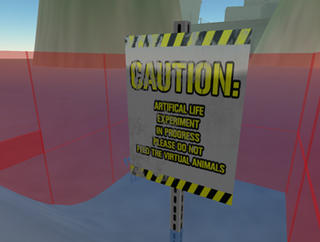Chaotic Possibilities

Statistically speaking it is not at all unlikely that a group of individuals all swimming around with a single purpose might find themselves in synchronicity. Even though a room full of people all clapping sounds like noise, there are moments -- however brief -- where everyone claps at the same time.
Mathematically, the probability of chaos suggests that unity is not possible; or at the very least is highly unlikely. So in a swarm, if each individual moves of their own mind -- even though they share a common purpose with those around them -- it is highly unlikely that they will find themselves moving synchronously with their neighbours.
Last night however, my small artificial life experiment proved probability wrong.
I had decided last night to give my swarming technique a stress test. So far it had all been working fabulously with a mere 6 fish or so. In this brief experiment, I created 14 of them and set them loose in their pen. While I was dismayed to watch them floundering around almost aimlessly, I soon became fascinated by the seemingly random moments where they actually swam in a common direction.
I suppose much of their confusion was because their population was far too dense for the size of the pen and thus they were constantly hitting obstacles and having to find a new direction. However, it did tell me that I need to spend a little more time working out the kinks.
Therefore, tonight I intend to run a controlled experiment to the swarm math against swarm size. I'm theorizing that the greater the size of the swarm, the higher the attractive force is to its center. I'm also going to infer a solution: giving the fish their first characteristic: leadership.
I mention this inferrance due to another interesting behaviour I've noticed with these fish: a leader tends to dart out ahead from time to time, and leads the pack for a while. I get the feeling that this first species will be an exploratory fish...
I'll post my results soon!


2 Comments:
Just as a note in case you're new to LSL. Sensors in SL can only see the nearest 15 objects that you're scanning for. So if you've got 20 fish, they can only see 15 other fish instead of all 20.
As a result of this, you might notice "sub groups" form.
Thanks for the comment. :)
I am aware of the limitations of the sensor event in SL, and perhaps might find a way around it.
Wouldn't sub-groups be interesting though, eh? :)
Post a Comment
<< Home